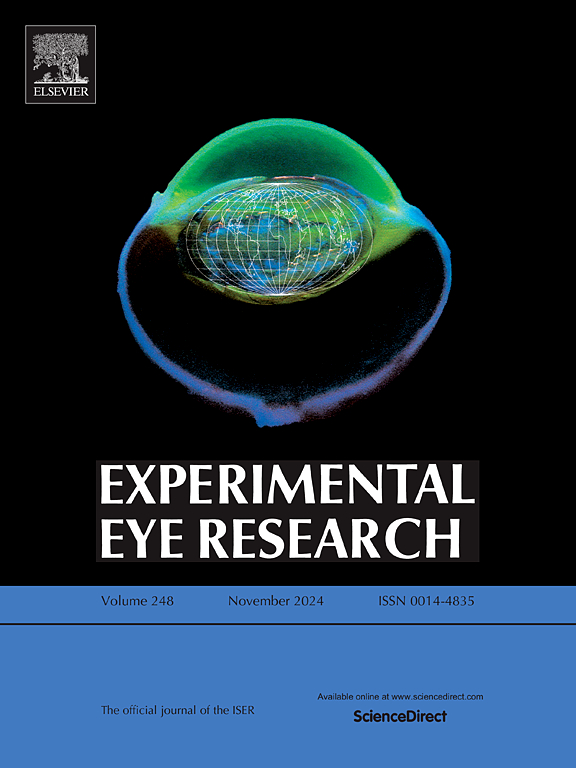Visualizing sphingomyelin in the retina
IF 3
2区 医学
Q1 OPHTHALMOLOGY
引用次数: 0
Abstract
Sphingomyelin (SM) is a major component of cellular membranes that is altered by retinal and optic nerve degenerations. However, our understanding of the influence of SM during degenerations is hampered by methodological limitations. Prior investigations have demonstrated the accumulation of SM to plasma membranes of cultured cells, using an enhanced green fluorescent non-toxic truncated form of lysenin (EGFP-NT-Lys), which is a protein that specifically binds to SM. Here, we used EGFP-NT-Lys and a permeabilization-free method for immunohistochemistry, which preserves membrane integrity, to demonstrate the accumulation of SM to the plasma membranes of retinal ganglion cells (RGCs) and retinal endothelial cells (RECs) of the intact mouse retina. To determine the sensitivity and selectivity of EGFP-NT-Lys for SM and SM species, we performed lipid dot blot assays. We found EGFP-NT-Lys is highly selective for SM and preferentially binds to longer-chain SMs. We confirmed that EGFP-NT-Lys labeling of SM is modifiable by treatment with the catabolic enzyme, sphingomyelinase. In addition, we verified EGFP-NT-Lys binding to SM by competition assays and EGFP. Confocal image analysis of immunofluorescence of RGC and REC markers and EGFP-NT-Lys labeling in flat mount mouse retinas revealed SM heavily accumulates within the retinal vasculature and around the perimeter of RGCs. Our data demonstrates that EGFP-NT-Lys combined with a permeabilization-free method for immunohistochemistry can be used to detect and quantify plasma membrane associated SM in defined cells of the intact retina.
可见视网膜中的鞘磷脂。
鞘磷脂(SM)是由视网膜和视神经变性改变的细胞膜的主要成分。然而,我们对SM在退化期间的影响的理解受到方法限制的阻碍。先前的研究已经证明SM在培养细胞的质膜上积累,使用增强的绿色荧光无毒截短形式的lysenin (EGFP-NT-Lys),这是一种特异性结合SM的蛋白质。在这里,我们使用EGFP-NT-Lys和无渗透性的免疫组织化学方法(可以保持膜的完整性)来证明SM在完整小鼠视网膜的视网膜神经节细胞(RGCs)和视网膜内皮细胞(RECs)的质膜上的积累。为了确定EGFP-NT-Lys对SM和SM物种的敏感性和选择性,我们进行了脂质点印迹实验。我们发现EGFP-NT-Lys对SM具有高度选择性,并优先结合较长链的SM。我们证实EGFP-NT-Lys标记可以通过分解代谢酶鞘磷脂酶修饰。此外,我们通过竞争实验和EGFP验证了EGFP- nt - lys与SM的结合。平贴小鼠视网膜中RGC和REC标记物的免疫荧光共聚焦图像分析和EGFP-NT-Lys标记显示SM在视网膜血管内和RGC周围大量积聚。我们的数据表明,EGFP-NT-Lys结合无渗透免疫组织化学方法可用于检测和定量完整视网膜中确定细胞的质膜相关SM。
本文章由计算机程序翻译,如有差异,请以英文原文为准。
求助全文
约1分钟内获得全文
求助全文
来源期刊

Experimental eye research
医学-眼科学
CiteScore
6.80
自引率
5.90%
发文量
323
审稿时长
66 days
期刊介绍:
The primary goal of Experimental Eye Research is to publish original research papers on all aspects of experimental biology of the eye and ocular tissues that seek to define the mechanisms of normal function and/or disease. Studies of ocular tissues that encompass the disciplines of cell biology, developmental biology, genetics, molecular biology, physiology, biochemistry, biophysics, immunology or microbiology are most welcomed. Manuscripts that are purely clinical or in a surgical area of ophthalmology are not appropriate for submission to Experimental Eye Research and if received will be returned without review.
 求助内容:
求助内容: 应助结果提醒方式:
应助结果提醒方式:


